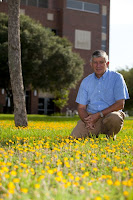 |
| Black-Eyed Peas |
Theresa Barduek
Urban Horticulture Extension Agent
If you come to us from up north, this is the time of year you would normally enjoy vegetable gardening. That’s not usually the case here in Florida. Sure, there’s plenty of sunshine and usually lots of rain… but the heat, oh my, the heat. Most crops people really want to grow just won’t perform in our subtropical summer temps, and it can be downright brutal to weed your garden mid-July. But what if you are determined to garden in the summer anyway? Besides sunscreen and lots of water to hydrate yourself, what do you need to know?
Summer crops for Florida are limited. Things like watermelon, black-eyed peas, okra, and sweet potatoes are best this time of year. If you are more interested in getting ready for the more diverse fall vegetable gardening season, black-eyed peas are a great choice. They are legumes and the help fix nitrogen in their roots. If you grow these as a cover crop and turn the plants into the soil before they produce peas, you will help nourish your soil with more nitrogen for the fall. You can grow and harvest the peas if you like, but this will reduce the amount of nitrogen put back into the soil.
 |
Okra Flower
|
Sweet potatoes are healthy (superfood anyone?) and they grow on rather beautiful vines. Growing this crop is a great way to keep down weeds in your garden while keeping it beautiful all summer long. I don’t have much to say about okra- can you tell I’m not a fan? But, if you like gumbo this is the crop for you! Finally, watermelon is a fun crop, and a summertime favorite that would be ready late August or early September if you got it planted right now. You’re going to need some space for this one, as watermelon vines can grow up to 12’-16’ long! Plan accordingly.
All of the usual tips and techniques apply when gardening in the summer as well. Things like mulching to keep down weeds and scouting for pests regularly to avoid infestation are always great advice. Keep an eye on plants to make sure they are getting enough water. We usually get plenty of water from rain in the summer, but not always. Be sure to avoid letting your garden wilt in the extreme summer heat. Plants grown in containers will need more frequent watering to avoid this. For this and much more about vegetable gardening- at any time of year- please visit
http://edis.ifas.ufl.edu/pdffiles/VH/VH02100.pdf. This handy link will give you the tools to succeed in your Florida garden any time of year, including planting dates, best varieties for Florida, and times to harvest.
Or you could just hit the beach… it’s hot out there!



